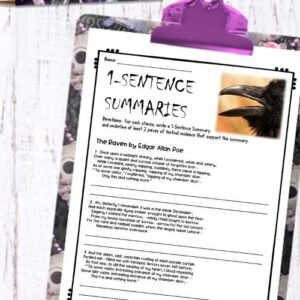The poetry of Edgar Allan Poe has challenged readers over the last hundred and fifty years; however, when we think of Poe, we might first think of his short stories. Eerie and suspenseful, Poe’s most taught stories include “The Tell-Tale Heart,” “The Masque of the Red Death,” and “The Cask of Amontillado.” And rightly so! His stories engage us because he mirrors our own emotions involving obsession, death, and revenge.
We are fascinated by his short tales because we see ourselves in the speakers, and this realization scares the bejeezus out of us.
In contrast, the poetry of Edgar Allan Poe most often focuses on love in some way, shape, or form. His perception of love involves realistic experiences and often death. And let’s be real; love always ends. The relationship always breaks up or the couple, just like the rest of humanity, ultimately dies.
Well, if you need help with teaching his poetry, keep reading for lessons, questions, and activities to engage any student who reads Poe!
Need help with Test Prep? Check out this FREE Pack of 3 Test Prep Activities to help students achieve success on standardized tests!
Poetry of Edgar Allan Poe Teaching Ideas
“The Raven”
When one considers how to include the poetry of Edgar Allan Poe in the classroom, Edgar Allan Poe’s most famous poem is most likely “The Raven.” It describes a person’s infatuation and mania regarding his love, Lenore, who has died. The raven, as a symbol of death, has arrived. Instead of embracing the death of his loved one, he waits for her in denial.
We are no different really. Instead of accepting the death of a person we love or our separation from this person (i.e. the death of the relationship), we wait in unending agony.

Here are some activity ideas for this Poetry of Edgar Allan Poe:
#1. Summarize the Stanzas-
Writing a good summary is tough. Why not practice the skill of summarizing and citing evidence? Here is an example from stanza 1:
Directions: For each stanza, write a 1-Sentence Summary and underline at least 2 pieces of textual evidence that support the summary.
The Raven by Edgar Allan Poe
1 Once upon a midnight dreary, while I pondered, weak and weary,
Over many a quaint and curious volume of forgotten lore—
While I nodded, nearly napping, suddenly there came a tapping,
As of some one gently rapping, rapping at my chamber door.
“’Tis some visitor,” I muttered, “tapping at my chamber door—
Only this and nothing more.”
Ex. While the narrator reads a book late at night, something taps on his door.
Click HERE for a poetry of Edgar Allan Poe bundle to make teaching “The Raven” FUN and EASY!
#2. Write about Literary Devices-
This poem is riddled with repetition, tone, metaphor, etc. So why not take the time to teach some literary devices?
Here is an example based on repetition: repeating words, phrases, sentences, or ideas
Ex. “Nevermore” –> By repeating “Nevermore” throughout the poem, the Raven symbolizes the speaker’s frustration and hopelessness concerning his experience with Lenore’s death. It conveys a sense of finality that the speaker cannot escape, even though he desperately tries to. The Raven merely echoes what he knows in his own heart: Lenore’s death led to their eternal separation.
You can even end on a writing prompt:
Short Response: How does Poe use literary devices to contribute to the central idea of “The Raven?” Use evidence to support your ideas.
#3. Visualize the Poem-
Visualization is so powerful! When good readers read, they usually create an image in their heads. It helps us to learn and retain as we read.
You can have your students do the same for this poem!
Directions: Write down THREE descriptions of the narrator from Edgar Allan Poe’s “The Raven.” Draw a detailed visual of the narrator based on the Textual Evidence.
Want to read more about Edgar Allan Poe? Click to read about his top 3 short stories and how to teach them!
“Annabel Lee”
This poem relays the tale of the speaker’s all-consuming love for Annabel Lee. She has passed away due to either the vengeful spite of those in heaven or a medical condition brought on by the cold. He ends the poem by literally or figuratively laying beside his love for the rest of time. Who really knows when it comes to the poetry of Edgar Allan Poe?

#1. Examine Poetic Language-
It takes a strong teacher to help students break down a line of poetry, let alone a whole poem. Why not help your students with specific phrases/lines in the poem?
- What is the effect of the repetition of the word “child” in the following line? “I was a child and she was a child”
- What is the effect of the description within the following lines? “That the wind came out of the cloud by night, / Chilling and killing my Annabel Lee.”
- What does the phrase “she lived with no other thought” (first stanza) reveal about Annabel Lee?
#2. Depict the Scene-
When students create or draw, they usually begin to engage more with a text. This process is also true when it comes to poetry. After reading and maybe rereading the poem, let students take the time to reflect on what the poem says and draw a scene.
It doesn’t have to be perfect; it simply needs to be supported by textual evidence.
Don’t simply accept a drawing of any kind. Encourage students to write down the evidence used to depict the scene.
Afterward incorporating this activity based on the poetry of Edgar Allan Poe, give students the opportunity to do a Gallery Walk, present in class, or share with a small group!
#3. Give a Quick Quiz-
Our students need help with standardized tests, and really, we cannot wait until the last minute in May to teach them the test-taking skills required to be successful!
Why not include a quick quiz for students to take after they have read and visualized the poem?
Click HERE for a test prep quiz based on the standards, made for “Annabel Lee!”
“The Bells”
If you want a fun, easy poem to teach, then “The Bells” might just be the ticket. It follows the relationship of a couple throughout their lives, including the initial euphoria, difficult times, and their demise.
With only 4 stanzas, students can easily comprehend this poem with a little bit of help!

1. Offer Differentiated Reading Comprehension Questions to help with reading the Poetry of Edgar Allan Poe
- Onomatopoeia-
- What is an example of onomatopoeia in the following lines? “What a tale their terror tells / Of Despair! / How they clang, and clash, and roar!”
- What is the effect of the onomatopoeia in the following lines? “What a tale their terror tells / Of Despair! / How they clang, and clash, and roar!”
- Tone-
- How is the speaker feeling at the beginning of the poem?
- What is the speaker’s tone at the beginning of the poem? Explain. Part B: Which 2 quotations support your answer to Part A?
- Theme-
- What are some major ideas in the poem?
- This question has 2 parts. Part A: What is the theme of the poem? Part B: Which 2 quotations support the answer to Part A?
2. Draw 1 Stanza
You can let students choose a stanza or assign a stanza based on length for differentiation.
Then, give them simple directions.
Ex. Using 6 pieces of textual evidence, draw a scene from “The Bells.”
If you want to further your differentiation when teaching the poetry of Edgar Allan Poe, encourage students to provide varying levels of cited evidence. Plus, you can do this with any Poetry of Edgar Allan Poe!
3. Compare the Poem to a Film Clip
Watch the film clip “I Can Hear the Bells” from Hairspray. Take the time to compare and contrast the poem as the students watch and then rewatch.
Directions: Write down at least 5 phrases you hear from the clip that connect with the meaning of the song. Then, go back and reread “The Bells” by Edgar Allan Poe and complete the chart with 5 phrases that connect with the poem’s meaning for the first and second stanzas.
The poetry of Edgar Allan Poe can be super simple, yet fun!
Need some help with test prep? Read the blog post: Reading Comprehension High School Worksheets: Creating and Teaching With Test Prep In Mind
Why Teach the Poetry of Edgar Allan Poe?
Ultimately, Poe is a master craftsman. His work should be read for its language, engagement, and rigor. Who can match his style and finesse in the American Literature Mystery Genre?
Now, when reading the Poetry of Edgar Allan Poe, I implore you to take your time. Your students may initially struggle, and that is okay.
Breathe it in; spend time on it. Help your students break it down, so they too can enjoy the suspense, excitement, and connection to the darkness of humanity we all see ourselves in!
If you want ready-made lessons, activities, and standards-based, test prep quizzes for the Poetry of Edgar Allan Poe as well as 3 of Poe’s most famous short stories, click HERE!
Craving more ideas for teaching the Poetry of Edgar Allan Poe? Check out my store Kristin Menke-Integrated ELA Test Prep!







